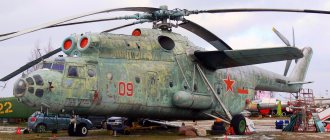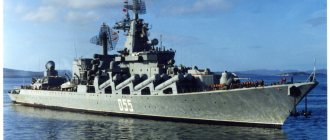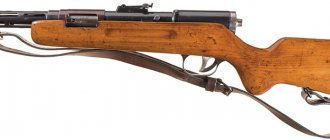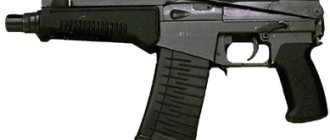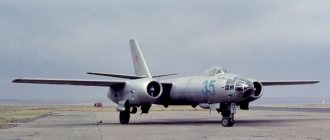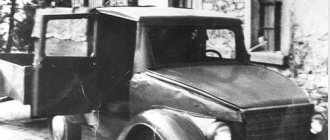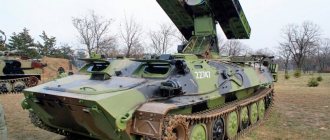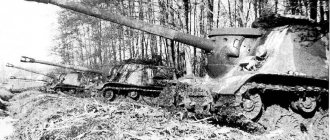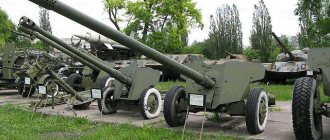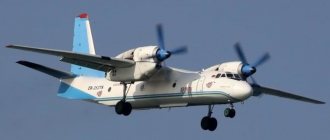The main tank T-72 was designed at the Uralvagonzavod design bureau (Nizhny Tagil) under the leadership of V.N. Venediktov in 1967-1973. A prototype of the tank, designated Object 172M, was manufactured at the end of 1970. The tank, designated T-72 "Ural", was put into service on August 7, 1973. During serial production in 1974-1996, Uralvagonzavod (Nizhny Tagil, 1974-1996 - 19973 units) and Chelyabinsk Tractor Plant (Chelyabinsk, 1978-1990 - 1874 units) produced 21,847 T tanks -72 all modifications. Since 1977, the tank was produced under license in Czechoslovakia (1977-1991 - 815 units), Poland (1979-1995 - 759 units), India (1988-2000 - 500 units), Iraq (100 pcs.), Iran (1993-2001 300 pcs.).
Description of the design of the T-72 "Ural" tank
The layout of the T-72 tank is classic, with the power compartment located aft. The tank's crew consisted of three people, located: the tank commander - in the turret to the right of the gun; driver - in the bow of the hull along the longitudinal axis; The gunner is in the turret to the left of the gun.
The tank hull is a rigid box welded from rolled armor plates. It consists of the bow, sides, stern, bottom, as well as fan and engine partitions and a roof over the power compartment.
The bow of the hull consists of upper and lower inclined armor plates, welded together, as well as with the front roof sheet, sides and bottom. The upper frontal sheet of the hull is inclined at an angle of 68° to the vertical and is a multi-layer combined barrier (steel-fiberglass-steel) with a thickness of 80+105+20=205 mm. The lower armor plate, 85 mm thick, is installed at an angle of 600. The sides of the hull are vertical armor plates 80 mm thick in the front and 70 mm in the rear. Turret protective strips are welded into the middle part of the sides to increase the internal volume of the hull and install the turret. The hull stern consists of a stern armor plate, a lower stern plate and gearbox housings. The hull roof consists of front and rear armor plates and inserts over the turret protective strips, welded to the hull, as well as a removable part. The bottom of the body is trough-shaped and consists of three stamped parts. To increase rigidity and place torsion bars in the bottom, longitudinal and transverse stampings are made. To protect the sides of the tank from cumulative weapons, 3 mm thick side screens made of aluminum alloy are designed. Four right and four left side screens are attached to the fenders and front flaps. In the combat position they rotate forward at an angle of 60°.
The tank turret is a shaped casting made of armored steel, to the top of which a roof is welded, as well as right and left heads for protecting the base tube of the rangefinder sight. The tower has a monolithic structure with variable wall thickness. The thickness of the frontal armor in the sector ±30° from the longitudinal axis of the tank is 400-410 mm with an inclination of 10-25°. The thickness of the sides ranges from 395-440 mm with tilt angles of 20-25°.
In front of the turret there is an embrasure for installing a cannon. To the right of the gun embrasure in the turret there is an embrasure for a coaxial machine gun. To the left of the gun embrasure a bracket for the night sight illuminator and a tube for supplying the electrical wire to it are welded. The tower is mounted on a ball support, the upper shoulder strap of which is connected to the bottom plate of the tower, and the lower shoulder strap is attached to the roof of the hull. The rotation of the tower is carried out using hydraulic and manual rotation mechanisms.
The tank's armament consists of one 125-mm smoothbore tank cannon D-81TM stabilized in two planes, one 12.7-mm NSV-12.7 machine gun mounted on a ZU-72 anti-aircraft gun (mounted on the commander's cupola shoulder strap), and 7. 62-mm PKT machine gun coaxial with a cannon. For aiming when firing from a cannon and coaxial machine gun, a monocular stereoscopic sight-rangefinder with independent stabilization of the field of view in the vertical plane TPD-2-49 and an electro-optical monocular periscopic night sight TPN-1-49-23 are used. For aiming when firing from an anti-aircraft machine gun, a K-10 collimator sight and a frame sight were used. Stabilization of the tank's armament is carried out by a two-plane electro-hydraulic stabilizer of tank armament 2E28M "Siren".
The gun is loaded by an electromechanical automatic loader of a cabinless type, with a capacity of 22 trays of shots. The tank's ammunition consists of 39 rounds of separate loading for the cannon, 300 rounds of ammunition for the anti-aircraft machine gun and 2,000 rounds of ammunition for the coaxial machine gun.
The power plant of the tank uses a 12-cylinder V-shaped four-stroke multi-fuel liquid-cooled diesel engine V-46 with a power of 780 hp. The tank's transmission is mechanical, with hydraulic control, and consists of a gearbox and two planetary gearboxes, structurally combined with final drives. Providing seven forward gears and one reverse gear.
Read: Heavy military transport aircraft Il-76
The undercarriage, for one side, consists of six dual-slope rubber-coated track rollers, three single-pitch support rollers with internal shock absorption, one rear drive wheel with removable ring gears and one idler wheel with a crank track tensioning mechanism. The tank's suspension is individual torsion bar, with hydraulic shock absorbers on the 1st, 2nd and 6th road wheels. Tracks, 580 mm wide, fine-linked for 97 tracks, lantern engagement, with a rubber-metal (RMSh) or open (OMSh) hinge.
The electrical equipment is made according to a single-wire circuit (the emergency lighting and the OPVT pump-out pump are made according to a two-wire circuit). Voltage - 27 V (for starter circuit - 48 V).
To protect the tank crew from weapons of mass destruction, a collective protection system is used, consisting of: a GO-27 radiation and chemical reconnaissance device, ZETS11-3 equipment for controlling sealing actuators, a filter-ventilation unit (FVU), actuators, a ventilation valve and a ventilation hatch, and a pressure gauge. To extinguish a fire in the reserved volume of the tank, an automatic triple-action system UA PPO "Rosa-2" is used. To extinguish minor fires there is a manual carbon dioxide fire extinguisher OU-2. Thermal smoke equipment is used to set up a smoke screen.
Equipment for underwater driving of a tank (OPVT) is used for the tank to overcome water obstacles up to 5 m deep and up to 1000 m wide along the bottom. To open trenches and shelters, the tank is equipped with self-digging equipment located outside on the lower bow sheet of the hull. KMT-6 blade-action gauge trawls can be installed on some tanks.
To maintain external communications, the tank is equipped with an ultrashort wave radio station R-123M, and for internal communications - a tank intercom R-124.
Protective systems
Despite the fact that the weight of the T-72 tank was impressive, it was equipped with additional systems that protected the armored vehicle from weapons of mass destruction. The systems are capable of protecting the tank and its internal equipment from shock waves and radiation during a nuclear explosion, ensuring the safety of the crew when exposed to toxic substances or biological weapons.
Protection against shock waves is provided by thoughtful armor, as well as high-quality sealing. A special reliable material is used inside the tank, while the fighting compartment and control compartments are reliably sealed. The protection system acts as a light and sound alarm, controls the level of radiation and excess pressure inside the tank and the presence of toxic substances outside it.
The fire-fighting system consists of three two-liter cylinders filled with fire extinguishing agent, as well as three pipelines that connect the cylinders and compartments, and nine temperature sensors. A special multiple-action system provides reliable protection against smoke. It runs on diesel fuel.
Among the additional equipment of T-72 tanks, we can note the underwater driving system, which allows you to overcome water obstacles at a depth of 5 m and a width of up to 1000 m. This equipment also includes life jackets and gas masks designed for all crew members.
Main modifications of the T-72 "Ural" tank
“Object 172” is an experimental medium tank designed at Uralvagonzavod under the leadership of L.N. Kartsev in 1967-1968. The first prototype of the tank was manufactured in the summer, the second in September 1968. Factory tests carried out until the end of 1968 showed insufficient reliability of the chassis, which led to its modification on the new experimental tank “Object 172M”. It was not put into service or into mass production.
The Object 172 tank differed from the T-64A:
— reinforced armoring of the frontal part of the turret without combined armor barriers; — electromechanical automatic loader of the cabinless type with a capacity of 22 trays with shots. The tank's ammunition load was 39 rounds of separate loading for the cannon and 2,000 rounds of ammunition for the coaxial machine gun; — using a V-45K diesel engine with a power of 730 hp in the power plant.
“Object 173” is an experimental medium tank designed at Uralvagonzavod under the leadership of L.N. Kartsev in 1968. Two prototypes of the tank were manufactured in 1968 by converting from serial T-64A tanks. In the summer of 1969, comparative tests were carried out with the Object 172 and T-64A tanks. It was not put into service or into mass production. The only difference from the serial T-64A tank was the power plant and the fan cooling system.
“Object 172M” is an experimental medium tank designed at Uralvagonzavod under the leadership of N.V. Venediktov in 1969-1970. At the end of 1970, three prototypes of the tank were produced. In November 1970 - April 1971, the Object 172M tanks successfully passed factory tests. In the first half of 1973, 15 tanks of the pilot batch successfully passed military tests. Later it became the basis for the serial T-72 tank. The “Object 172” differed from the experimental tank in the installation of the V-46 engine with a power of 780 hp, the design of the air cleaner and chassis.
“Object 172M-2M” (theme “Buffalo”) is an experimental main tank designed at the Uralvagonzavod Design Bureau under the leadership of N.V. Venediktov in 1973-1974. In the first half of 1974, a prototype of the tank was manufactured. Passed factory tests in 1974-1975. It was not put into service or into mass production. The T-72 differed from the serial tank:
— Increasing the angle of inclination of the upper frontal part of the hull to 70 degrees and using combined armor barriers in the design of the frontal part of the turret. — Installation of an improved 125-mm D81TM cannon, characterized by higher accuracy, a TPD-K1 laser sight-rangefinder, a Buran-PA night passive-active sight, a Jasmine tank weapon stabilizer with an electric drive in the horizontal plane, an increase in ammunition to 45 rounds guns. — The power plant used a V-46F engine with a power of 840 hp. The fuel supply has been increased, allowing the range to be increased on one fill up to 1000 km. — Reinforced onboard planetary gearboxes were used in the power transmission. — An improved chassis has been installed with increased dynamic travel of the road wheels.
Read: Monitor ships of the Zheleznyakov type
T-72 "Ural" ("Object 172M") - a serial version of the tank "Object 172", manufactured at Uralvagonzavod (Nizhny Tagil) in 1974-1975 in the amount of 950 units. In 1975, the tank received its proper name “Ural”.
T-72 "Ural-1" ("Object 172M1") - an improved version of the serial tank "Object 172M", manufactured at Uralvagonzavod (Nizhny Tagil, 1975-1979 - 4727 units) and ChTZ (Chelyabinsk, 1978-1979 - 340 units) in 1975-1979 in the amount of 5067 units. It differed from the T-72 tank of the 1973 model:
— reinforced armor of the hull and turret; — since 1977, a cast turret with combined armor filled with sand cores was installed; — the gun is equipped with a heat-protective casing; — The L-2AG IR spotlight has been moved to the right cheekbone of the frontal part of the turret.
From 1975 to 1980, an export version of the tank was produced, designated T-72 (“Object 172M-E”). It was distinguished by the design of the armor protection of the frontal part of the turret, the PAZ system and the configuration of ammunition.
T-72K "Ural-K" ("Object 172MK") is a serial command tank designed at the Uralvagonzavod Design Bureau under the leadership of N.V. Venediktov based on the design of the serial T-72 tank in 1973. Serially produced at Uralvagonzavod (Nizhny Tagil) in 1974-1980. It differed from the T-72 linear tank by the installation of an additional short-wave radio station R-130M, navigation equipment TNA-3 "Kvadrat", an autonomous power supply unit AB-1, and a reduction in the cannon's ammunition load to 31 rounds.
T-72A (“Object 176”) is a serial main tank designed by the Uralvagonzavod design bureau under the leadership of N.V. Venediktov based on the design of the T-72 tank in 1979. The tank was put into service on June 22, 1979. During serial production at Uralvagonzavod (Nizhny Tagil - 7062 units) and ChTZ (Chelyabinsk - 680 units) in 1980-1984, 7742 T-72A tanks of all variants were produced.
It differed from the T-72 tank:
- reinforced armoring of the hull and turret; in the frontal part of the turret, which received protrusions - “cheekbones”, combined armor barriers made of sand rods were used; - installation of a 125-mm 2A46 cannon, which featured a smoother recoil when fired due to a fluid compensator in the recoil brake, which increased the accuracy and range of the shot; installation of a modernized 2A46M cannon since 1981. The gun's ammunition load was increased to 44 rounds; — installation of a laser sight-rangefinder TPD-K1 and an active-passive night sight TPN-3-49. Since 1982, the 1A40 sighting system has been installed on the tank, including the TPD-K1 laser sight-rangefinder; - improved V-shaped 12-cylinder diesel engine V-46-6 with a power of 780 hp. s., since 1984 a new V-84 engine with a power of 840 hp was installed. With. Since 1985, the tank has been equipped with a more efficient air cleaner and an intake air heating system (IAH); — installation of on-board solid rubber-metal anti-bulking screens; — since 1980, the 902A “Cloud” smoke grenade launch system and the “Sota” napalm protection system were installed.
In 1980, an export version of the T-72 tank was developed, designated T-72M. It was distinguished by monolithic armor of the hull and turret and the installation of an ESD instead of the SKZ. In 1982, based on the design of the T-72M tank, a modernized version was created - the T-72M1, which was distinguished by the use of combined armor barriers in the design of the frontal parts of the hull and turret, and the welding of a 16-mm armor plate to the upper part of the frontal part of the hull. Since 1985, the T-72A and T-72M1 tanks, respectively designated T-72AV and T-72M2, began to be equipped with a set of mounted dynamic protection.
T-72AK (“Object 176K”) is a serial command tank designed at the Uralvagonzavod Design Bureau under the leadership of N.V. Venediktov based on the design of the serial T-72A tank in 1979. Serially produced at Uralvagonzavod (Nizhny Tagil) in 1979-1984. It differed from the linear tank T-72A by installing an additional short-wave radio station R-130M, navigation equipment TNA-3 "Kvadrat", an autonomous power unit AB-1, and reducing the tank's ammunition load to 36 rounds for the gun.
T-72B (“Object 184”) is a serial main tank designed at the Uralvagonzavod design bureau under the leadership of N.V. Venediktov based on the design of the T-72A tank in 1981-1984. The tank was put into service on January 23, 1985. During serial production at Uralvagonzavod (Nizhny Tagil, 1985-1996 - 9425 units) and ChTZ (Chelyabinsk 1985-1990 - 850 units) in 1985-1996, 10275 T-72B tanks of all variants .
It differed from the T-72A tank:
- increasing the level of security (an additional 20-mm armor plate was welded to the upper part of the frontal part of the hull, a new turret with an increased package of combined armor barriers, a set of mounted dynamic protection "Contact" (227 containers) (in 1988, NDZ containers were installed on the tank turret in two tiers), a smoke screen system 902B “Cloud”, a napalm protection system “Soda” and high-speed fire-fighting equipment 3 ETs 13 “Rime”); — installation of a smooth-bore 125-mm gun-launcher 2A46M with a 9K120 “Svir” guided missile system and a two-plane stabilizer for tank weapons 2E42-2 “Jasmine” (vertical guidance stabilizer - electro-hydraulic, horizontal guidance - electric machine), sighting system 1A40-1 ( laser sight-rangefinder TPD-K1 and ballistic correction device), atmospheric conditions sensor DVE-BS with an interface unit (since 1991), sight-guidance device 1K13-49 (could be used as an active-passive night sight), increased to 45 shots ammunition for the gun; — using in the power plant a multi-fuel four-stroke high-speed liquid-cooled diesel engine V-84-1 with a power of 840 hp; — the tank is equipped with an auxiliary power unit; — using the Paragraph communications complex (ultra-short wave radio station R-173, radio receiver R-173P, a block of antenna filters and laryngophone amplifiers).
Read: Combat helicopter MI-28N
Some of the tanks, designated T-72B1 (“Object 184-1”), were produced without a guided missile system. Instead of the 1K13-49 sight-guidance device, these tanks were equipped with a TPN-3-49 night sight.
Since 1987, an export version of the T-72B tank began to be produced, designated T-72S, distinguished by the installation of the Kontakt dynamic protection kit for 155 containers. A version of the tank without a guided missile system was designated T-72S1. Since 1992, T-72S tanks began to be equipped with built-in dynamic protection for the hull and turret.
Since 1989, UVZ has produced tanks designated T-72B model 1989, with built-in Kontakt-5 dynamic protection for the hull and turret.
In 2000, the T-72BA tank (“Object 184A”), designed at UKBTM as part of the program of deep modernization of the T-72 tank in 1992-2000, was put into service. The modernization of T-72 tanks has been carried out during major overhauls at Uralvagonzavod since 1998 (in 1994-1997, no work was carried out on the modernization of the T-72 tank).
It differs from the T-72B tank:
- automated fire control system 1A-40-1M or 1A-40-M2, equipped with a digital tank ballistic computer on a microprocessor; — the power plant uses a multi-fuel four-stroke high-speed liquid-cooled diesel engine V-92S2 with a power of 1000 hp. and reinforced transmission; — automatic fire-fighting system ZETS13 “Iney” with two multiple actions; — the chassis is unified with that of the T-90A tank.
T-72B1 tanks undergo the same modernization, receiving the designation T-72BA1 (“Object 184A1”).
In 2006, UKBTM developed an option for modernizing the T-72B tanks, which received the designation T-72B2 “Slingshot” (“Object 184M”). It was planned to produce tanks from 2012 through modernization during a major overhaul at UVZ, but were later abandoned in favor of the T-72B3 project.
It differs from the T-72BA tank:
— installation on the hull and turret of a set of built-in dynamic protection “Relikt” and a system of electromagnetic protection of the tank against mines with a magnetic fuse, a complex of optical-electronic protection “Shtora-1”; — installation of a smooth-bore 125-mm cannon 2A46M-4 (M-5) with an optical-electronic device to improve shooting accuracy, a multi-channel combined sight “Sosna-U” with a guided missile guidance channel, a block for correcting ballistic characteristics in the control system (sight-rangefinder TPD -K1 was left as a reserve), the ammunition included a high-power fragmentation-shrapnel and armor-piercing sub-caliber projectile with a core made of super-dense single-component and composite materials; — the introduction of the “Cape” camouflage kit and anti-cumulative lattice screens into the tank kit.
In 2011, UKBTM developed a modernization option for the T-72 tank, designated T-72B3. Since 2012, the tank has been supplied to the Russian Armed Forces (as of 2020, there are 800 tanks).
It differs from the T-72B2 tank:
— the gun’s ammunition included a shot with a 3BM-46 “Lead” sub-caliber anti-tank projectile with a 3BM-48 propellant charge; — a TKN-3MK tank commander’s sight with the “Double” system and a 2nd generation image intensifier was installed; — the power plant uses V-84-1 engines with a power of 840 hp. or V-92S2 with a power of 1000 hp; — an ultrashort wave radio station R-168-25U-2 “Aqueduct” with two transceivers was installed.
T-72BK (“Object 184K”) is a serial command tank designed by UKBTM (Nizhny Tagil) under the leadership of N.V. Venendiktov based on the design of the T-72B tank in 1987. The tank entered service in 1987. Serially produced until 1996 at Uralvagonzavod (Nizhny Tagil). It differed from the T-72B linear tank by the installation of an additional short-wave radio station R-130M, navigation equipment TNA-4, an autonomous power unit AB-1, and a reduction in the ammunition load for the gun.
A little history
In the summer of 1961, the first two copies of the tank were built, and they were tested in an accelerated manner - first at the factory, then at the test site. The facility was modernized, but despite all its advantages, the plant did not receive official permission to produce a new tank. Year after year, certain changes were made to the model:
- First, the crew of the T-72 tank was thought out, which consisted of three people - a commander, a gunner and a driver.
- The tank was equipped with a cannon with an automatic loader and armor protection based on the design of the Steel Research Institute.
- The chassis of the model was planned to weigh no more than 40 tons.
But these changes were not accepted, only two onboard gearboxes were left.
Power department
The aft part has a power compartment. The engine of the T-72 tank is located on the left side, and between it and the partition for the engine there is a cooling system, an oil filter, and an expansion tank valve. An air purifier is installed on the right side. The hull has a rear sheet where the cooling system is located. The power compartment is also equipped with additional and main oil tanks, which help lubricate the engine. The power compartment is closed with a lid. The fuel consumption of the T-72 tank per 100 km is as follows:
- when driving on the ground - 260-450 l;
- on paved roads - 240 liters.
